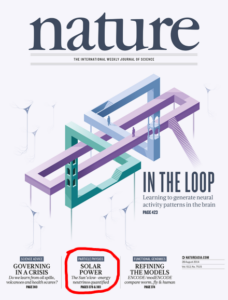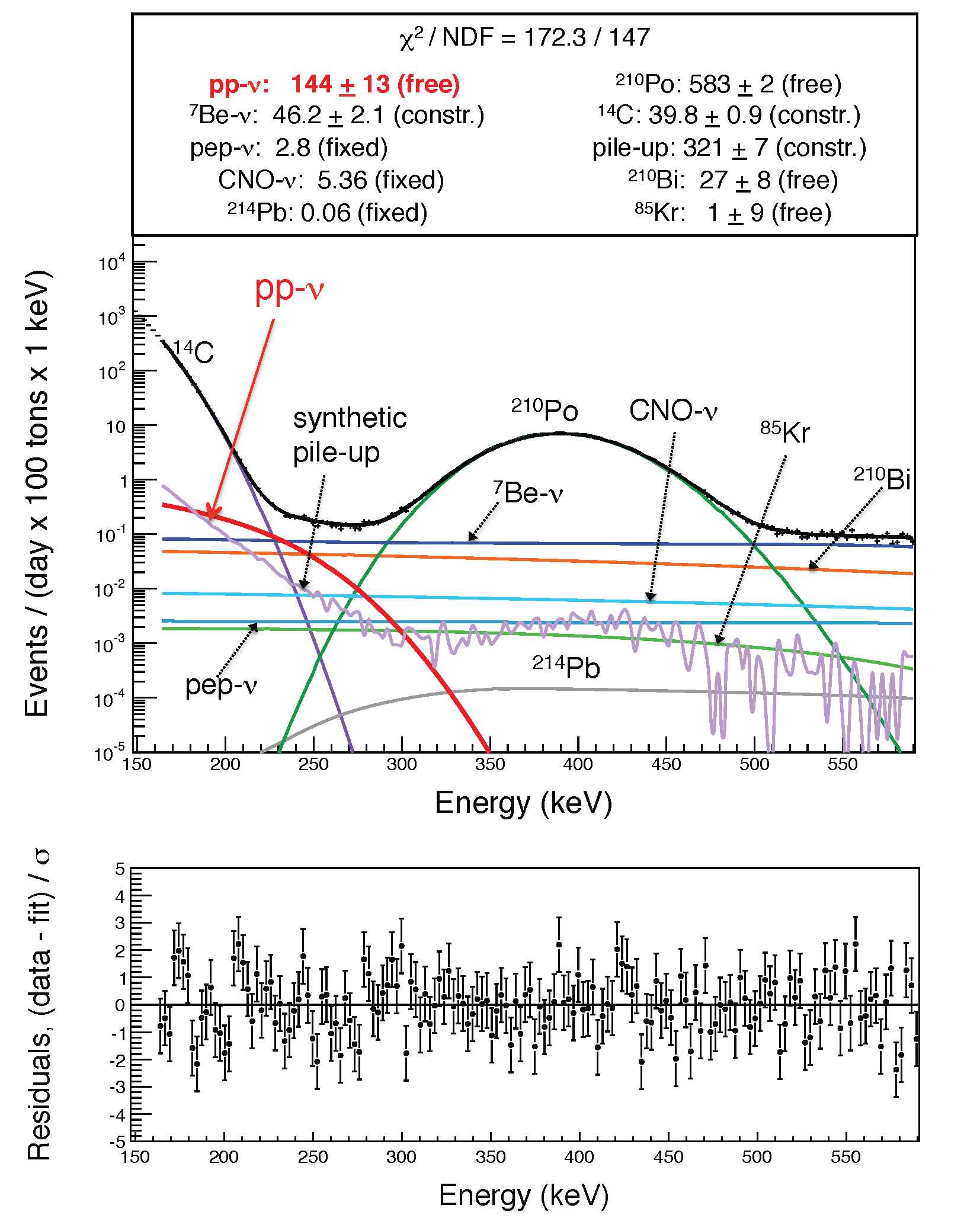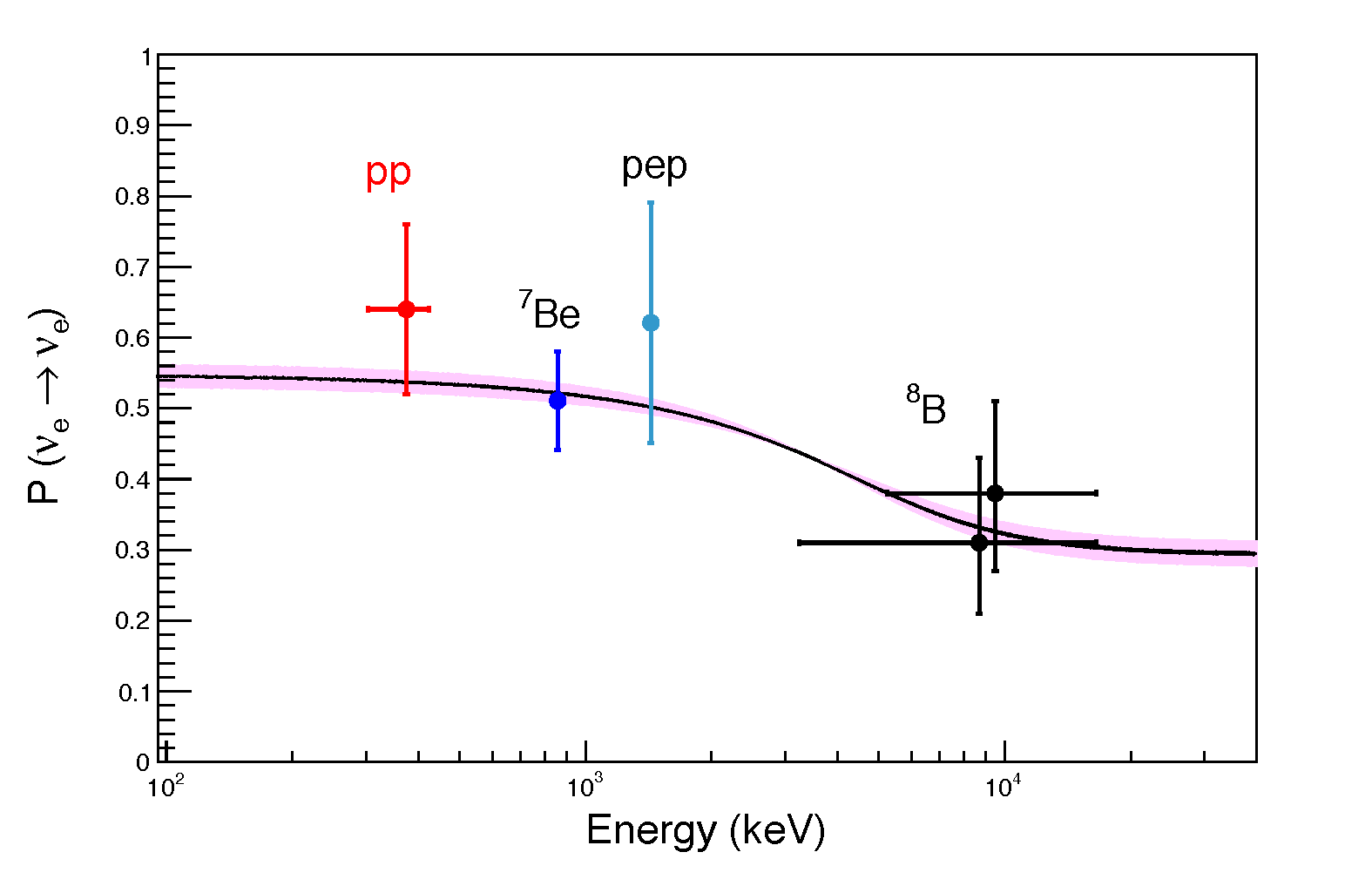Table of Contents Show
 Neutrinos from the primary proton-proton fusion process in the Sun
Neutrinos from the primary proton-proton fusion process in the Sun
Nature 512, 383-386 (28 August 2014)
Data availability: The datasets generated during the current study are freely available (see below). Additional information is available from the Borexino Collaboration spokesperson (spokesperson-borex@lngs.infn.it) upon reasonable request.
It looks like our results on p-p neutrino measurement have attracted some general public interest. See below for a (likely incomplete) list of articles appeared on the international press.
Abstract
In the core of the Sun, energy is released through sequences of nuclear reactions that convert hydrogen into helium. The primary reaction is thought to be the fusion of two protons with the emission of a low-energy neutrino. These so-called pp neutrinos constitute nearly the entirety of the solar neutrino flux, vastly outnumbering those emitted in the reactions that follow. Although solar neutrinos from secondary processes have been observed, proving the nuclear origin of the Sun’s energy and contributing to the discovery of neutrino oscillations, those from proton–proton fusion have hitherto eluded direct detection. Here we report spectral observations of pp neutrinos, demonstrating that about 99 per cent of the power of the Sun, 3.84 × 1033 ergs per second, is generated by the proton–proton fusion process.
Open Data
In 2014, the Borexino collaboration published (Nature 512, pp 383 2014) the first real-time measurement of neutrinos from the proton-proton fusion process.
In the core of the Sun, energy is released through sequences of nuclear reactions that convert hydrogen into helium. The primary reaction is thought to be the fusion of two protons with the emission of a low-energy neutrino. These so-called pp neutrinos constitute nearly the entirety of the solar neutrino flux, vastly outnumbering those emitted in the reactions that follow. Although solar neutrinos from secondary processes have been observed, proving the nuclear origin of the Sun’s energy and contributing to the discovery of neutrino oscillations, those from proton–proton fusion have hitherto eluded direct detection. Here we report spectral observations of pp neutrinos, demonstrating that about 99% of the power of the Sun, 3.84 × 1033 ergs per second, is generated by the proton–proton fusion process.
 This plot (as given in Fig. 3 of the Borexino Nature paper) reports the fit of the Borexino energy spectrum between 165 and 590 keV and the relative residuals. The properties of the data bins and residuals are available here.
This plot (as given in Fig. 3 of the Borexino Nature paper) reports the fit of the Borexino energy spectrum between 165 and 590 keV and the relative residuals. The properties of the data bins and residuals are available here.
 This plot, as shown in “Extended Data Figure 2″ of the Borexino Nature paper, reports the ± 1
This plot, as shown in “Extended Data Figure 2″ of the Borexino Nature paper, reports the ± 1![]() prediction of the MSW-LMA solution for the electron survival probability as well as the survival probability points associated to the Borexino experimental measurements of pp, 7Be, pep and 8B solar neutrino flux.
prediction of the MSW-LMA solution for the electron survival probability as well as the survival probability points associated to the Borexino experimental measurements of pp, 7Be, pep and 8B solar neutrino flux.
Numerical values for the electron survival probability band are available here while the coordinates of the experimental Borexino measurements can be found here.
News Coverage
- Scientific News
- Astronomy News (Umass release)
- CERN Courier
- Interactions.org (= INFN press release)
- NSF
- Nature News (Ron Cowen)
- Wick Haxton on Nature
- New Scientist
- Phys.org
- Phys.org
- Physics World (IOP) (Ken Croswell)
- Science 2.0
- Science News
- Science Recorder
- Science Word Report
- Scientific American (Clara Moskowitz)
- Science Now (Dan Clery)
- Slashdot.org
- Smithsonian Magazine
- Space.com (Nola Taylor Redd)
- Symmetry magazine
- The Space Reporter
- Space Daily
- Tech Times
- Tech Times
- UMass
- UMass Physics Departement
- Australia
- Australian Broadcasting Corporation (Stuart Gary)
- IB Times
- SBS
- The Conversation
- Brazil
- Inovacao Technologica
- Techenet
- China
- Cuba
- Czech Republic
- France
- CNRS
- French Tribune
- Le Figaro
- Liberation
- Radio France Inter (interview with D.Vignaud and D.Franco)
- Rappler
- Germany
- Hungary
- Italy
- Abruzzoweb.it
- ADN Kronos
- Altopascio.it
- ANSA
- ASCA
- Blitz
- Brescia Oggi
- Capannori News
- Corriere della Sera
- Corriere della Sera
- Corrispondenti.net
- Ecoseven
- Europa Quotidiano
- Focus
- Galileo
- GSSI
- Il Centro
- Il Secolo XIX
- Il Sussidiario
- L’impronta L’Aquila
- Italia chiama Italia
- Italia Globale
- Italia Globale
- La Stampa
- La Stampa
- Le Scienze
- Media INAF
- MeteoWeb
- motls.blogspot.it
- PrimaPress
- PrimaPress
- Quotidiano di Ragusa
- News Town
- La Repubblica
- La Repubblica
- La Repubblica (ocasapiens blog)
- tecnici.it
- Wired.it
- Zazoom
- Lebanon
- Lichtenstein
- Luxemburg
- Netherlands
- Poland
- Romania
- South Africa
- Spain
- ABC.es
- Entorno Intelligente
- Europa Press
- Finanzas.com
- La Razon
- Prensa Libre
- RTVE
- Universo Canario
- Sudan
- Switzerland
- Tahiti
- UK
- Big News Network
- Daily Mail
- Deccan Chronicle
- Global Post (same as Yahoo UK)
- IBTimes
- The Register
- Yahoo UK
- USA
- Before Its News
- Christian Science Monitor (Peter Spotts)
- Daily Hampshire Gazette (Amherst)
- Daily Hampshire Gazette (Scott Mertzbach, basically UMass release)
- Design & Trend
- ECN Mag
- Eurekalert
- Headlines and Global News
- Huffington Post (same as Science News)
- Laboratory Equipment
- Mayine Tree Consciousness
- Nanowerk (from German release)
- Nature World News
- North Denver News
- New York Times (Sindya Bhanoo)
- News Maine
- Raw Story
- RT USA
- Sci-news
- Uncover California
- Yahoo News
- Vietnam
Pingback:Borexino listed in 2014 Top Ten of Physics World – Borexino Experiment